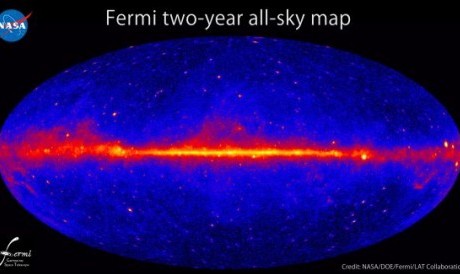1. What Are Fermi Bubbles?
No, this is not a rare digestive disorder. The bubbles are massive, mysterious structures that emanate from the Milky Way’s center and extend roughly 20,000 light-years above and below the galactic plane. The strange phenomenon, first discovered in 2010, is made up of super-high-energy gamma-ray and X-ray emissions, invisible to the naked eye. Scientists have hypothesized that the gamma rays might be shock waves from stars being consumed by the massive black hole at the center of the galaxy.
2. Rectangular Galaxy
“Look, up in the sky! It’s a…rectangle?” Earlier this year, astronomers spotted a celestial body, roughly 70 million light-years away, with an appearance that is unique in the visible universe: The galaxy LEDA 074886 is shaped more or less like a rectangle. While most galaxies are shaped like discs, three-dimensional ellipses or irregular blobs, this one seems to have a regular rectangle or diamond-shaped appearance. Some have speculated that the shape results from the collision of two spiral-shaped galaxies, but no one knows for now.
3. The Moon’s Magnetic Field
One of the moon’s greatest mysteries—why only some parts of the crust seem to have a magnetic field—has intrigued astronomers for decades, even inspiring the buried mythical “monolith” in the novel and film 2001: A Space Odyssey. But some scientists finally think they may have an explanation. After using a computer model to analyze the moon’s crust, researchers believe the magnetism may be a relic of a 120-mile-wide asteroid that collided with the moon’s southern pole about 4.5 billion years ago, scattering magnetic material. Others, though, believe the magnetic field may be related to other smaller, more recent impacts.
4. Why Do Pulsars Pulse?
Pulsars are distant, rapidly spinning neutron stars that emit a beam of electromagnetic radiation at regular intervals, like a rotating lighthouse beam sweeping over a shoreline. Although the first one was discovered in 1967, scientists have for decades struggled to understand what causes these stars to pulse—and, for that matter, what causes pulsars to occasionally stop pulsing. In 2008, though, when one pulsar suddenly shut off for 580 days, scientists’ observations allowed them to determine that the “on” and “off” periods are somehow related to magnetic currents slowing down the stars’ spin. Astronomers are still at work trying to understand why these magnetic currents fluctuate in the first place. Read more
Sources
- The Smithsonian
- Image: SolStation
News category: Features.




